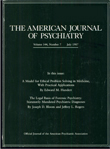The classification of depression: traditional versus mathematical approaches
Abstract
The authors examine the classification of depressive disorders with an empirically and mathematically based method, cluster analysis. In a sample of 228 patients from the NIMH Collaborative Study of the Psychobiology of Depression, clusters were generated by using crossectional symptoms; course of illness, family history, and treatment variables were used as independent variables to evaluate the validity of the clusters. The four clusters identified correspond roughly to severe depressions with endogenous features, less severe depressions, bipolar depression with cycling within the episode, and psychotic depressions. This study supports the Research Diagnostic Criteria and DSM-III approaches to the classification of depressive disorders.
Access content
To read the fulltext, please use one of the options below to sign in or purchase access.- Personal login
- Institutional Login
- Sign in via OpenAthens
- Register for access
-
Please login/register if you wish to pair your device and check access availability.
Not a subscriber?
PsychiatryOnline subscription options offer access to the DSM-5 library, books, journals, CME, and patient resources. This all-in-one virtual library provides psychiatrists and mental health professionals with key resources for diagnosis, treatment, research, and professional development.
Need more help? PsychiatryOnline Customer Service may be reached by emailing [email protected] or by calling 800-368-5777 (in the U.S.) or 703-907-7322 (outside the U.S.).



